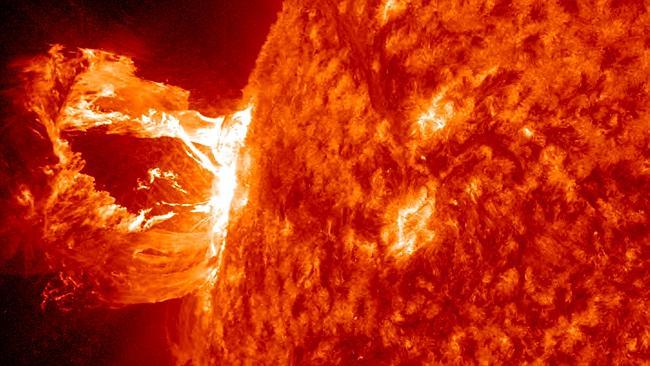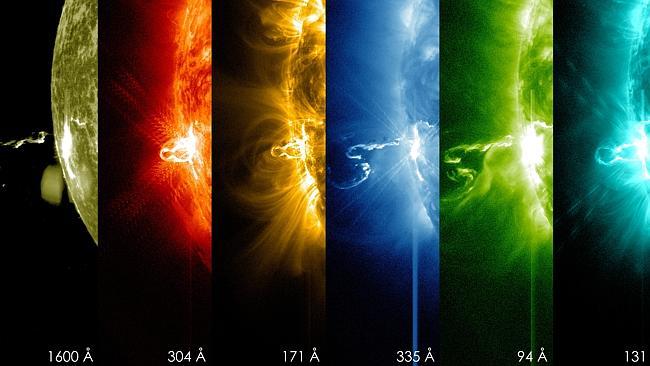Could a giant solar flare from the sun cause a catastrophe on Earth?
WHAT would happen if the sun suddenly erupted a gigantic solar burst aimed right at our planet? It’s the silent natural disaster looming above our heads.

Space
Don't miss out on the headlines from Space. Followed categories will be added to My News.
THE sun just spat out its largest solar burst this year. Luckily, it wasn’t aimed at Earth, but could one of these giant eruptions bring our planet to a grinding halt?
When the sun got angry in 1859, American telegraph operators saw sparks fly.
A huge solar flare belched a cloud of charged particles into Earth’s path. But other than frying telegraph lines, the electromagnetic collision caused little stir in the world.
Nobody back then had yet switched on an incandescent light bulb, much less charged an iPhone.
Yet the sun hasn’t changed its ways, and that worries University of Kansas physicist Adrian Melott, among others.
MORE: THE SEVEN STRANGEST THINGS SEEN IN SPACE
What if a similar solar flare struck the planet today?
“Gee, I’d be without cable TV,” Melott deadpanned.
Without email too, some fear. No heating or cooling. No electric grid.
Satellite technology, it was nice knowing you.
This is the scenario rolling out from a growing network of scientists, policymakers and survivalists. Not quite doomsday because life itself would continue, but a silent natural disaster that could unplug us from all we depend upon.
“It’s happened before, as recently as 1989,” said astrophysicist David Hathaway of NASA’s Marshall Space Flight Centre in Alabama.
“That geomagnetic storm took out a big transformer in New Jersey.” Still, it was no “Carrington event,” named for British astronomer Richard Carrington, who charted the 1859 solar burst. Scientists today regard what happened in 1989 as a mere sun-to-Earth wakeup call, an electromagnetic puff, though strong enough to knock out power in Quebec and parts of the US.
Hathaway said the Big One, Carrington-style, “could be catastrophic,” leaving effected areas without juice for months or years.
A 2009 study by the National Academy of Sciences warned that a massive geomagnetic assault on satellites and interconnected power grids could result in a blackout from which the nation may need four to 10 years to recover.
“The earth is in peril, and people love that,” said Benjamin Radford, deputy editor of Skeptical Inquirer magazine. “There is this certain human fascination with disaster. But given a world so interconnected and dependent on technology, with all our mobile phones and computers, there’s some legitimate scientific concern about this.” Odds of an electronics Armageddon anytime soon are far from clear.
Because solar storms occur regularly, with magnetic loops flaring and twisting around sunspots, government weather scientists say it’s inevitable that Earth will, on rare occasion, get bonked by what they call a “coronal mass ejection,” or CME.
A cloud of solar plasma, depending on the magnetic makeup of its electrons, could penetrate and shake the planet’s magnetic field, if the sun’s aim is just so.
Some say a super CME, capable of shorting out satellites around the globe and frying electric lines across a continent, might be a once-in-a-century event.

What are the odds of a solar flare catastrophe?
In May 2012, a US Geological Survey report estimated a 6 percent chance of another Carrington event occurring in the next decade.
Still, other researchers, such as NASA’s Hathaway, point out that for an event that big, the statistics are too flimsy to measure. The uncertainty rests in the relatively brief span of time in which scientists have recorded a link between sunbursts and electromagnetic fluctuations on Earth, the first being Carrington’s observations in 1859.
And even then, the world knew about it only because an emerging technology went haywire.
Sparks shocked telegraph operators and set fire to their paper. Electric surges created enough juice in some telegraph lines that operators were able to communicate even after disconnecting their batteries.
According to newspaper accounts, the Northern Lights could be viewed as far south as the Caribbean, the result of electrically charged particles from the sun entering Earth’s atmosphere.
But we do not know whether or not the Carrington event was as bad as sunstorms get.
Melott proposed that material from a solar megaflare 10 times the strength of the Carrington kind bombarded this planet around the year 775.
Where on Earth is most at threat?
As with hurricanes, earthquakes and tornadoes, electromagnetic natural disasters are believed to threaten some areas of Earth more than others.
Upper latitudes are more apt to get hit than places closer to the equator. Grids near large bodies of salt water or atop heavy concentrations of granite are at higher risk too.
“Everything shuts down,” said author Julie L. Casey.
“Without electricity, there is no manufacturing. No medicines. No processed food.”
“No gasoline could be refined or even oil drilled.” Such thoughts compelled her to write a novel published last year, How I Became a Teenage Survivalist.
“We can learn to live without electricity,” Casey said. “Ask any survivalist. The best place to be is out on a farm.”


